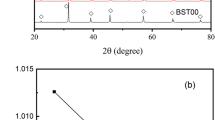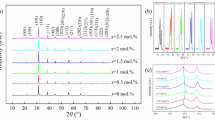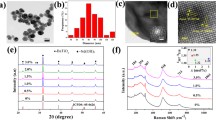Abstract
High-performance colossal permittivity (ε′ > 104) plays an indispensable role in the development of electronic field. In this work, ultra-high dielectric permittivity (ε′ > 237, 294 @1 kHz) and low dielectric loss (0.012 @1 kHz) were simultaneously achieved in Ta-doped BaTi0.995Ta0.005O3 ceramics. Importantly, the dielectric permittivity changes less than 15% between − 55 and 200 °C, and the dielectric loss is less than 0.04. The excellent giant dielectric performance is related to the defect dipoles of electronic pins associated with electrons/oxygen vacancies/Ti3+, which are generated by B-site donor. And the thermal-activated short-range hopping of electrons is conformed to be the origin of low dielectric losses and excellent thermal stability. This work provides a strategy for achieving ultra-high dielectric permittivity, low dielectric loss, and excellent temperature stability of Ta-doped BaTiO3 simultaneously through B-site defect engineering.





Similar content being viewed by others
Data availability
The authors declare that the data supporting the findings of this study are available within the paper and its Supplementary Information files. Should any raw data files be needed in another format they are available from the corresponding author upon reasonable request. Source data are provided with this paper.
References
W. Hu, Y. Liu, R.L. Withers et al., Electron-pinned defect-dipoles for high-performance colossal permittivity materials. Nat. Mater. 12, 821 (2013)
Y. Meng, K. Liu, X. Zhang et al., Defect engineering in rare-earth-doped BaTiO3 ceramics: route to high-temperature stability of colossal permittivity. J. Am. Ceram. Soc. 105, 5725 (2022)
Y. Wang, W. Jie, C. Yang et al., Colossal permittivity materials as superior dielectrics for diverse applications. Adv. Funct. Mater. 29, 1808118 (2019)
Z. Li, X. Luo, W. Wu et al., Niobium and divalent-modified titanium dioxide ceramics: colossal permittivity and composition design. J. Am. Ceram. Soc. 100, 3004 (2017)
X. Cheng, Z. Li, J. Wu, Colossal permittivity in ceramics of TiO2 co-doped with niobium and trivalent cation. J. Mater. Chem. A 3, 5805 (2015)
Z. Wang, Y.B. Li, H.N. Chen et al., Correlation between the radius of acceptor ion and the dielectric properties of co-doped TiO2 ceramics. Ceram. Int. 45, 14625 (2019)
L. Zhao, Q. Liu, J. Gao et al., Lead-free antiferroelectric silver niobate tantalate with high energy storage performance. Adv. Mater. 29, 1701824 (2017)
Y. Tian, L. Jin, Q. Hu et al., Phase transitions in tantalum-modified silver niobate ceramics for high power energy storage. J. Mater. Chem. A 7, 834 (2019)
X. Guo, Y. Pu, W. Wang et al., Colossal permittivity and low dielectric loss in Ta Doped strontium titanate ceramics by designing defect chemistry. J. Alloys Compd. 7, 834 (2019)
D.Y. Lu, Y. Yue, X.Y. Sun, Novel X7R BaTiO3 ceramics co-doped with La3+ and Ca2+ ions. J. Alloys Compd. 586, 136 (2014)
H. Han, C. Voisin, S. Guillemet-Fritsch et al., Origin of colossal permittivity in BaTiO3 via broadband dielectric spectroscopy. J. Appl. Phys. 113, 024102 (2013)
L. Sun, Z. Wang, W. Hao et al., Influence of Zirconium doping on microstructure and dielectric properties of CaCu3Ti4O12 synthesized by the sol-gel method. J. Alloys Compd. 651, 283 (2015)
L. Li, B. Zhang, The effect of bimodal model on the ultra-broad temperature stable BaTiO3-Na0.5Bi0.5TiO3-Nb2O5 system. Scripta Mater. 114, 170 (2016)
Y. Liu, R.L. Withers, X.Y. Wei, Structurally frustrated relaxor ferroelectric behavior in CaCu3Ti4O12. Phys. Rev. B 72, 134104 (2005)
B.S. Prakash, K.B.R. Varma, Influence of sintering conditions and doping on the dielectric relaxation originating from the surface layer effects in CaCu3Ti4O12 ceramics. J. Phys. Chem. Solids. 68, 490 (2007)
S. Rani, N. Ahlawat, R. Punja et al., Dielectric and impedance studies of La and Zn co-doped complex perovskite CaCu3Ti4O12 ceramic. Ceram. Int. 44, 23125 (2018)
R. Schmidt, M.C. Stennett, N.C. Hyatt et al., Effects of sintering temperature on the internal barrier layer capacitor (IBLC) structure in CaCu3Ti4O12 (CCTO) ceramics. J. Eur. Ceram. Soc. 32, 3313 (2012)
W. Li, R.W. Schwartz, Maxwell–Wagner relaxations and their contributions to the high permittivity of calcium copper titanate ceramics. Phys. Rev. B 75, 012104 (2007)
Y. Meng, K. Liu, X. Zhang et al., Compositional modulation and annealing treatment in BaTiO3 to simultaneously achieve colossal permittivity, low dielectric loss, and high thermal stability. Ceram. Int. 47, 33912 (2021)
H. Han, C. Davis, J.C. Nino, Variable range hopping conduction in BaTiO3 ceramics exhibiting colossal permittivity. J. Phys. Chem. C 118, 9137 (2012)
D. Lu, Y. Peng, X. Yu et al., Dielectric properties and defect chemistry of La and Tb co-doped BaTiO3 ceramics. J. Alloys Compd. 681, 128 (2016)
P. Ren, J. He, X. Wang et al., Colossal permittivity in Niobium doped BaTiO3 ceramics annealed in N2. Scripta Mater. 146, 110 (2018)
Z. Wang, M. Cao, Z. Yao et al., Giant permittivity and low dielectric loss of SrTiO3 ceramics sintered in nitrogen atmosphere. J. Eur. Ceram. Soc. 34, 1755 (2014)
X. Guo, Y. Pu, W. Wang et al., Colossal permittivityand low dielectric loss in Ta Doped strontium titanate ceramics by designingdefect chemistry. J. Alloys Compd. 818, 152866 (2020)
D. Wen, W. Hu, T.J. Frankcombe et al., Colossal permittivity with ultralow dielectric loss in in + Ta co-doped rutile TiO2. J. Mater. Chem. A 5, 5436 (2017)
H. Kishi, N. Kohzu, J. Sugino, The effect of rare-earth (La, Sm, Dy, Ho and Er) and mg on the microstructure in BaTiO3. J. Eur. Ceram. Soc. 19, 1043 (1999)
J. Pokorný, U.M. Pasha, L. Ben, Use of Raman spectroscopy to determine the site occupancy of dopants in BaTiO3. J. Appl. Phys. 109, 114110 (2011)
Q. Liu, J. Liu, D. Lu et al., Colossal dielectric behavior and relaxation in Nd-doped BaTiO3 at low temperature. Ceram. Int. 44, 7251 (2018)
W. Wang, L. Li, T. Lu et al., Multifarious polarizations in high-performance colossal permittivity titanium dioxide ceramics. J. Alloys Compd. 806, 89 (2019)
K. Shigemi, T. Syozo et al., Dilution effects on optical absorption and core-level photoelectron spectra of BaTiO3 mesocrystals. Physica E 5, 161 (1999)
J. Jumpatam, B. Putasaeng, N. Chanlek et al., Improved giant dielectric properties of CaCu3Ti4O12 via simultaneously tuning the electrical properties of grains and grain boundaries by F substitution. RSC Adv. 7, 4092 (2017)
K. Zhang, L. Li, M. Wang et al., The self-compensation mechanism in barium titanate ceramics with colossal permittivity. J. Alloys Compd. 851, 156856 (2021)
X. Wei, X. Wan, X. Yao, Dielectric relaxation in paraelectric phase of Ba(Ti,Sn)O3 ceramics. J. Electroceram. 21, 226 (2007)
Z. Wang, M. Cao, Q. Zhang et al., Dielectric relaxation in Zr-Doped SrTiO3 ceramics Sintered in N2 with Giant Permittivity and low dielectric loss. J. Am. Ceram. Soc. 98, 476 (2014)
Funding
This work was financially supported by the Key Research and Development Program of Shandong Province (2022CXGC020203), the Natural Science Foundation of China (Grant No. 12264012, 62271362,12162011,12304120), the Science and Technology Plan of Guangxi (Nos. AA21238001, AA21077012, AA22068080, AA23023027l,GA245006, ZY22096019, and ZY20198017), Young Elite Scientists Sponsorship Program by CAST (Grant No. 2021QNRC001) , the Natural Science Foundation of Guangdong Province (No. 2022A1515111013) and the Science and Technology Plan of Guilin (2022H03 and ZY20220101).
Author information
Authors and Affiliations
Contributions
All authors contributed to the study conception and design. Material preparation, data collection, and analysis were performed by Huang Chu and Meng Yingzhi. The first draft of the manuscript was written by Huang Chu and all authors commented on previous versions of the manuscript. All authors read and approved the final manuscript.
Corresponding authors
Ethics declarations
Competing interests
The authors declare no competing financial interest.
Additional information
Publisher’s Note
Springer Nature remains neutral with regard to jurisdictional claims in published maps and institutional affiliations.
Supplementary Information
Below is the link to the electronic supplementary material.
Rights and permissions
Springer Nature or its licensor (e.g. a society or other partner) holds exclusive rights to this article under a publishing agreement with the author(s) or other rightsholder(s); author self-archiving of the accepted manuscript version of this article is solely governed by the terms of such publishing agreement and applicable law.
About this article
Cite this article
Huang, C., Meng, Y., Li, C. et al. Colossal permittivity, low dielectric loss, and good thermal stability achieved in Ta-doped BaTiO3 by B-site defect engineering. J Mater Sci: Mater Electron 34, 2231 (2023). https://doi.org/10.1007/s10854-023-11623-z
Received:
Accepted:
Published:
DOI: https://doi.org/10.1007/s10854-023-11623-z




